The winners of the Nature Photographer of the Year (NPOTY) 2024 competition have been announced! This prestigious event celebrates the very best in nature photography, showcasing stunning work from talented photographers around the globe.
More info:naturephotographeroftheyear.com|Instagram|Facebook
This post may includeaffiliate links.
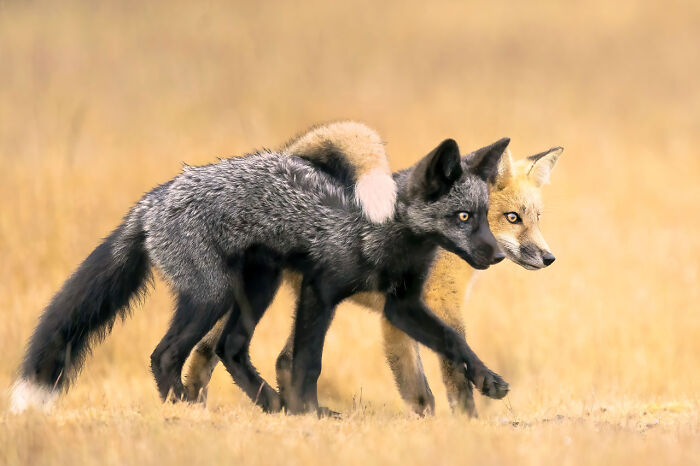
What elevates this image beyond a mere sighting is the technical excellence in capturing such explosive behavior in challenging mountain conditions, combined with the artistic merit of a composition that places these mysterious cats in their ethereal, high-altitude habitat.”
RELATED:
“In northern India lies Spiti Valley, a land of rugged beauty and home to one of the most elusive creatures on Earth: the snow leopard. For me, this journey has been a lifelong dream, as the snow leopard has always been my favorite wild animal.This year, my dream came to life during an unforgettable encounter with a pair of sub-adult snow leopard siblings. I had the privilege of observing and photographing them at various moments in their lives, capturing their grace and playfulness through my lens.The pinnacle of this extraordinary adventure came on the first of February. Achieving the image I had envisioned was no easy feat. I waited for over six hours at the edge of a canyon, braving temperatures plummeting to -25°C and a relentless snowstorm that chilled me to the bone. The two siblings had been resting in a cave, and I could only hope they would eventually emerge.When the storm subsided and calm returned, they began to stir. What unfolded next was beyond my wildest imagination. They climbed upward, chasing each other along snowy slopes, playing with a joy and vitality that left me awestruck. I remember whispering to myself repeatedly, “This can’t be real, it’s too incredible to be true!”And then came the moment. A frame so perfect, so alive, that even in my wildest dreams, I couldn’t have imagined capturing it. This image, and the experience behind it, will forever remain etched in my memory as one of the most magical days of my life.”
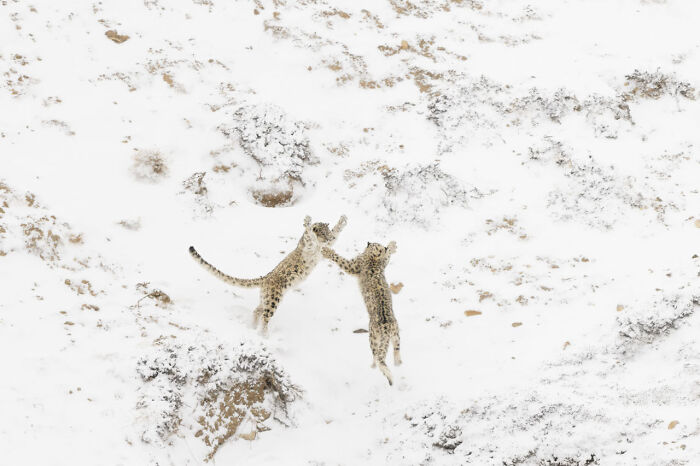

The overall winner, Paolo Della Rocca, mentioned that he never even dreamed of capturing such a moment. “I’m so glad and grateful that the jury of NPOTY 2024 appreciated this photograph!”

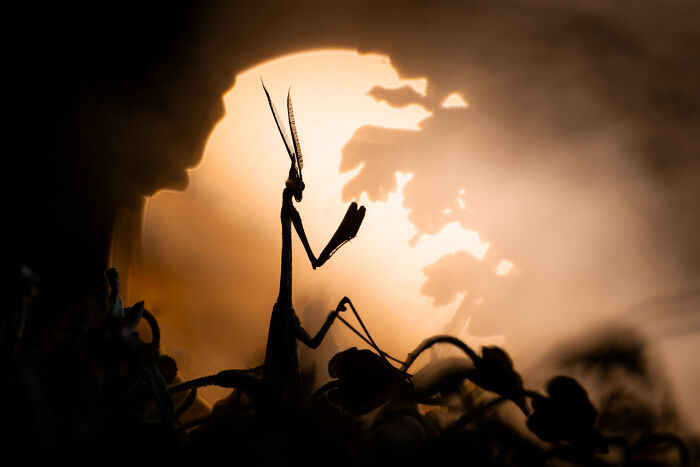
According to the organizers, among the other winners, runners-up, and highly commended entries, several notable names from the world of nature photography stood out. Thomas Vijayan was celebrated in the Birds category, Aaron Gekoski stood out in the Human and Nature category, and Paul Goldstein earned recognition in the Black and White category.
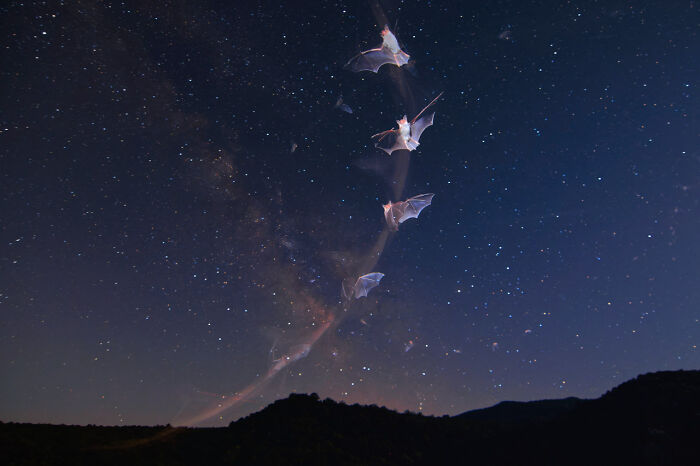
“In 2022, I had the privilege of traveling to the Falkland Islands in South America. During my two-week stay, I had the opportunity to observe and study the behavior of the four common penguin species found in the Falklands. At one location, I observed Gentoo Penguins returning from their hunts in the open sea, riding the waves as they came ashore. That moment inspired the image I had in mind, and I spent two afternoons attempting to photograph this behavior. Gentoo Penguins are the fastest swimmers among penguins, and they proved to be skilled surfers, even riding the waves on the other side.”

Members of this year’s judging panel included:● Tin Man Lee (USA), chair of the judging panel;● Marco Gaiotti (Italy);● Kevin Morgans (UK);● Joan de la Malla (Spain);● Barbara Dall’Angelo (Italy).
Members of this year’s judging panel included:
● Tin Man Lee (USA), chair of the judging panel;
● Marco Gaiotti (Italy);
● Kevin Morgans (UK);
● Joan de la Malla (Spain);
● Barbara Dall’Angelo (Italy).
“In the last five years I have been experimenting with growing crystals, using amongst others amino acids, and photographing them with the purpose of creating images that appeal to the imagination. This image, using alanine, glutamine, and N-acetyl L-cysteine, reminds me of strange sea anemones dancing in a ray of sunlight with little fish swimming around them.Amino acids are the stuff of life, as they are the building blocks for the proteins in all living creatures. Proteins provide structure, regulate body processes, transport materials and do a host of other things without which life would be impossible. All this thanks to the 23 amino acids that life makes use of, of which I used three in the creation of this image.Once the crystals have been prepared, I scan the crystals with the camera under cross-polarized light for interesting and appealing compositions. Some preparations show very regular patterns and may yield abstract images. Very irregular crystallization patterns offer a better chance of finding a more organic looking composition like the one in this photo. A crystal preparation is just like a landscape, you must walk through it and look at different orientations to find something of interest.However, there are many preparations that are not interesting and then I clean the petri dish and start over again.The crystals are made in a petri dish and are always translucent, but you can see the crystal patterns. However, if you want them to stand out, cross-polarized light is needed. To do that a led light is placed behind the crystals and a polarizing filter is placed before and after the crystals. By turning one of the polarizing filters the different crystal structures can be made visible. I used a polycarbonate plate between the crystals and the second polarizing filter to add more color to the image.The image is stacked, as the petri dish in which the crystals are formed, is nearly never perfectly flat or parallel to the sensor, and the dof is extremely thin at 3x magnification and an aperture of 4.”
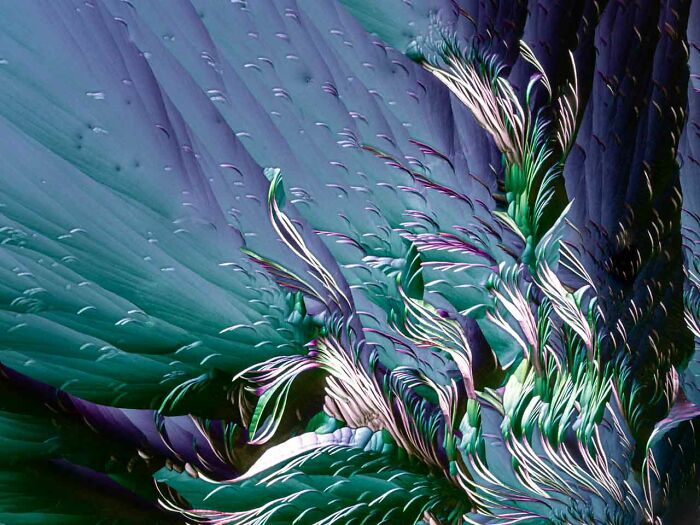
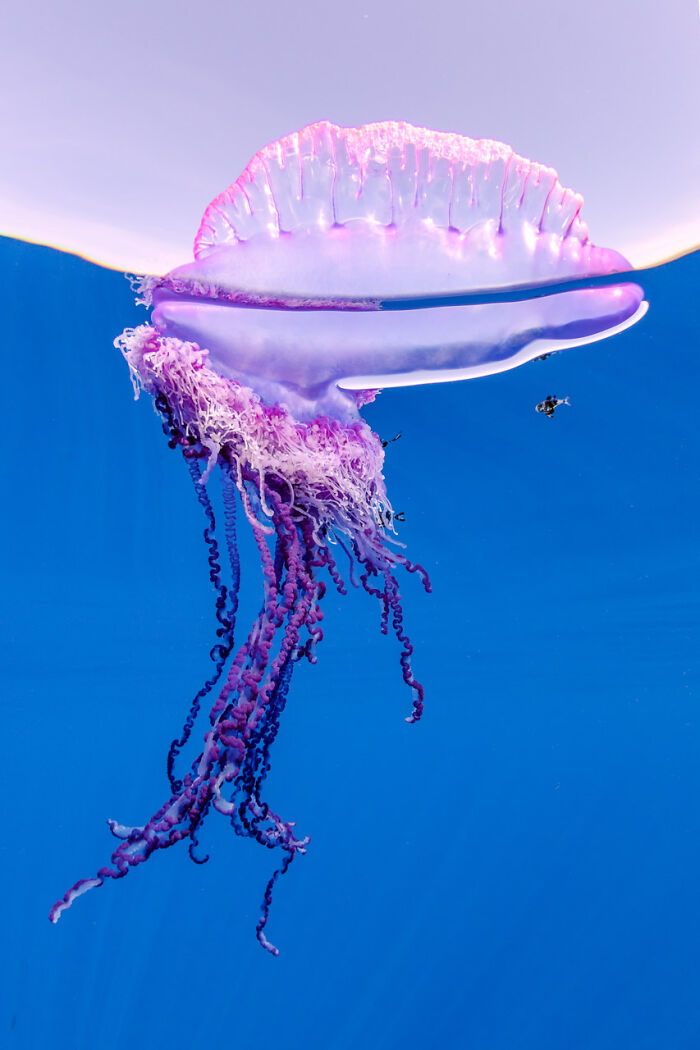
“It was -20C, so cold that we were engulfed in dense frozen fog. We were driving to find a puma to photograph in a private ranch near Torres del Paine National Park in Chile. I asked our guide to stop at a beautiful vista of the famous Towers (Torres). We got out and I set up to photograph the dramatic spires nestled in frozen fog. When I was just about to take my landscape photo, a guanaco (Lama guanicoe) appeared over the crest of the hill, intruding on my pristine setting.I waited for a few minutes to see if the animal might leave, but soon another one appeared, and then several more. Making a virtue of necessity, I thought about how the guanacos could complement the landscape. Zooming out to include the foreground, I took a series of pictures as the guanacos approached.I had owned several llamas (the domesticated descendants of guanacos), so I was familiar with their behavior. I could tell that the animals were not stressed as we stayed still on the road. Indeed, the lead animal showed all the signs of being curious, just like llamas. As it approached, I waited for the moment that it balanced the rest of the scene and took this picture.As often happens with wildlife photography, the moment was a mixture of preparation and luck (good and bad). The bad luck was that the previous day, I had dropped my main camera and fancy telephoto lens on the road, rendering both of them useless. I was prepared for such an event, with a backup camera body and a mid-range (70-200mm) lens. Unable to take closeup portraits or even detailed behavior images, I started to imagine compositions where the animal was a small part of a wider landscape. Having practiced this enforced perspective for a day, I was better prepared to react to the good luck of guanacos ‘spoiling’ my landscape photo.”


The myth of Iceland as a wild, inaccessible land, home to untameable natural forces, was born in me long before my passion for photography. For years, I delved into researching this country in intricate detail, meticulously planning my adventure among its waterfalls, glaciers, and wind-swept deserts.When news and photos of the first eruption in Iceland reached me in 2021, I was astonished. I had never imagined it would be possible to photograph such a force of nature! Determined to turn my research into reality, I decided to organize a photographic trip to Iceland the following year. From that moment, my journey became a true hunt for eruptions.I traveled to Iceland in July, only to find that the eruption had ended. Just 10 days after my return, another eruption began. Undeterred, I decided to return in September, but once again, the eruption had ended before I arrived.After two more trips, in July 2023, new reports from Iceland began to surface: the earth was shaking! Hundreds, even thousands of tremors followed each other for days. For two weeks, I anxiously waited, uncertain whether the activity would subside or if the earth would open up once more. Finally, I decided to take the chance and leave for Iceland, hoping for something extraordinary.As soon as my plane touched down, my phone lit up with notifications: the eruption had started just before I landed!I immediately rushed to the site, carrying 20kg of gear on my back, with 12km to trek and no idea what awaited me. What I witnessed and experienced over the four days I spent photographing this incredible force of nature, is both unforgettable and indescribable.For this particular image, captured during the eruption of Litli-Hrùtur, I chose the name Yggdrasill. In Norse mythology, Yggdrasill represents the cosmic tree whose roots sink deep into the underworld, while its branches extend to support the worlds, giving them life.Being in a country so steeped in myths and legends, faced with a phenomenon both awe-inspiring and terrifying, I couldn’t help but see the resemblance.The ‘roots’ of the volcano extend deep underground through the eruption’s crater, just as Yggdrasill’s roots delve into the underworld. From these roots, a mighty river of lava emerges, forming a ‘trunk’ that splits into numerous branches resembling a glowing crown of molten rock. These golden, radiant streams, like Yggdrasill’s branches, create, sustain, and transform the world around us.”

“A lovely black redstart was singing from our neighbor’s chimney, its song so clear that I could hardly hear anything else, save for the deep, subliminal rumble of Berlin in the distance. Every morning, long before sunrise, it sings in the dark, keeping me company when I wake up early.This morning, I left home with just my camera in hand and headed straight to my favorite nature spot. Even as a nine-year-old, I used to hide there, watching animals in secret.The air was foggy, quite cold, and dusk had already fallen as I walked along a small path through the area. A blackbird hopped in front of me, foraging for insects. The mystical atmosphere surrounding it, made me want to capture the scene. I lay down flat in the morning dew-damp grass for a better angle when, suddenly, four fallow deer emerged from the bushes right in front of me and paused on the path.We all stood still, observing each other, my heart pounding as it often does when encountering wild animals. The blackbird then moved between me and the fallow deer, and for a moment, we all seemed connected.A bit too excited to operate my camera perfectly, I managed to capture this beautiful moment just before the fallow deer slipped back into the bushes.”
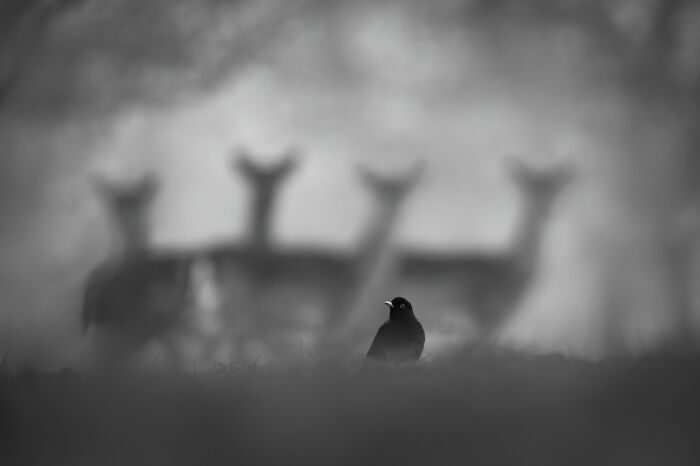
“I had originally hoped to return to South Africa in 2023 for another safari, but that didn’t pan out. However, a friend invited me to join her family in the Seychelles for a couple of weeks. Having never been before, I wasn’t quite sure what to expect in terms of wildlife photography. I reached out to the ICS (Island Conservation Society) team on the island and mentioned that I would be on Desroches Island for a couple of weeks. I offered to provide any photography services and get involved with any conservation projects while I was there. After working with the Giant Aldabra Tortoises, I was invited to join an early morning beach patrol to monitor bird species and track where turtles had come from the sea overnight to lay their eggs on the beach.I had hoped to witness and photograph turtle hatchlings making their way to the sea as the sun rose. The hatchlings instinctively wait until the sand cools, indicating nighttime, when there’s less risk of predation. As the sun rises, they use its light to guide them to the sea and as far away from shore as possible, where predation is highest. Unfortunately, only around 1 in 1000 hatchlings survive to adulthood. Once they leave the nest, predators such as birds, ghost crabs, and fish pose a significant threat.Ghost crabs are abundant on the beach, scavenging anything from fallen fruit and plants to decaying animals—and unfortunately, live turtle hatchlings. As I walked along the beach, I spotted several horned ghost crabs. One of them had something in its claws, and I realized it had caught one of the stragglers on its first journey to the sea. I immediately lay flat on the sand and switched my lens to a 300mm (600mm equivalent) prime. The crab was scuttling along the beach, dropping its prize and picking it up again. I waited patiently until it turned to face me, capturing the shot. Though it’s difficult to identify the species of the turtle, it was likely a critically endangered Hawksbill, which can be found around this remote island.”



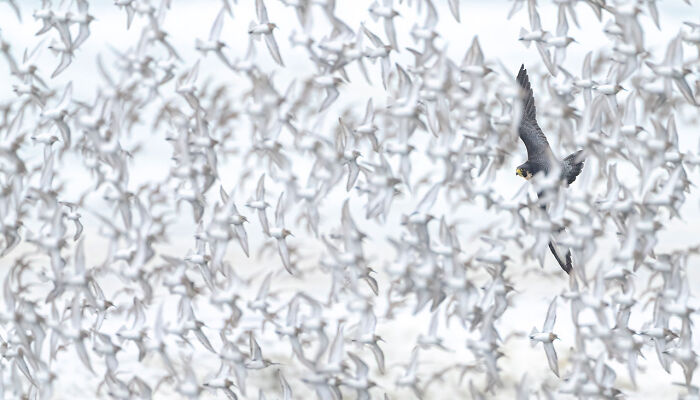
“Niete is a recently rescued chimpanzee (Pan troglodytes) saved from a poacher who intended to sell her as a pet, while her family was killed for bushmeat. When young chimpanzees lose their mothers before their eyes, they experience trauma and require extensive care and compassion to be rehabilitated. A dedicated team of caregivers is now providing round-the-clock attention to Niete at the Limbe Wildlife Centre, a rescue and rehabilitation center focused on the unique species of Cameroon.Rebuilding a bond of trust with a chimpanzee requires immense love and commitment. In this image, Niete has fallen asleep in the arms of Godlove after her bottle of warm milk at night. Godlove spends entire nights holding her close as she grows bigger, stronger, and confident enough to eventually be introduced to other chimpanzees rescued from the bushmeat trade.”
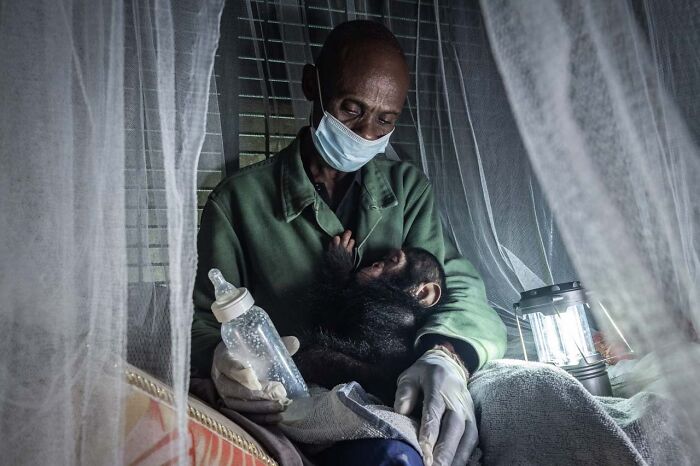
“The Amsterdamse Waterleidingduinen, a nature reserve in the Netherlands, plays a vital role in purifying drinking water for the city of Amsterdam. This unique area is also home to a thriving population of European fallow deer (Dama dama). Living near this reserve allows me to visit frequently and explore its natural beauty.On this particular morning, the reserve was shrouded in a hazy atmosphere, especially around the many small canals that wind through the landscape. As I wandered the area in search of subjects, I noticed a fallow deer standing still atop a dune. The deer’s motionless posture, combined with the misty surroundings, created a striking scene.Carefully, I positioned myself to frame the deer without any visual distractions. At the same time, I aligned my shot to block the sun and diffract its light, enhancing the dreamy quality of the moment. The result was a serene image that encapsulates the tranquil beauty of this special reserve.”

“At Wuhan’s East Lake, I often sit beneath the branches of this dragon jujube tree. The branches twist and meander upward in strange, beautiful shapes, adding a sense of abstraction and wonder to the scene. As I rest under the tree, I sometimes see one or two birds flying overhead. I waited patiently, hoping for the perfect moment to capture a larger group of birds soaring past. Perhaps my endless waiting paid off, as suddenly, a flock of migratory birds flew over these branches and vanished into the sky.Life defies logic; it’s full of unexpected moments and beauty. To capture this scene, I used a super wide-angle lens. I held the camera with live view mode to enhance the visual extension effect and capture the full, sweeping view overhead.”
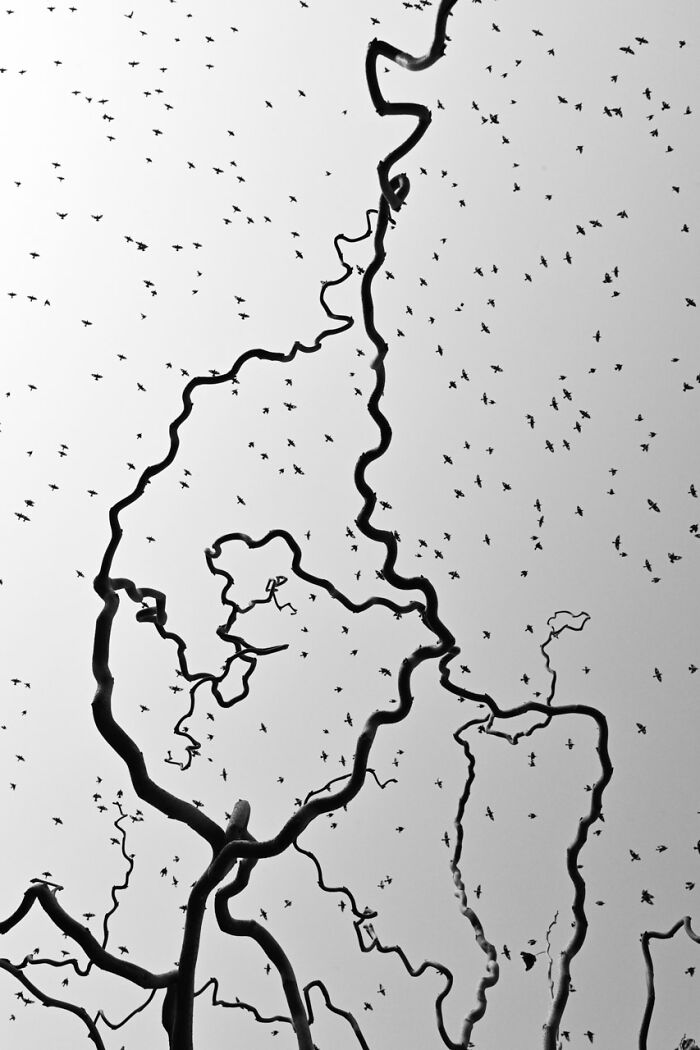
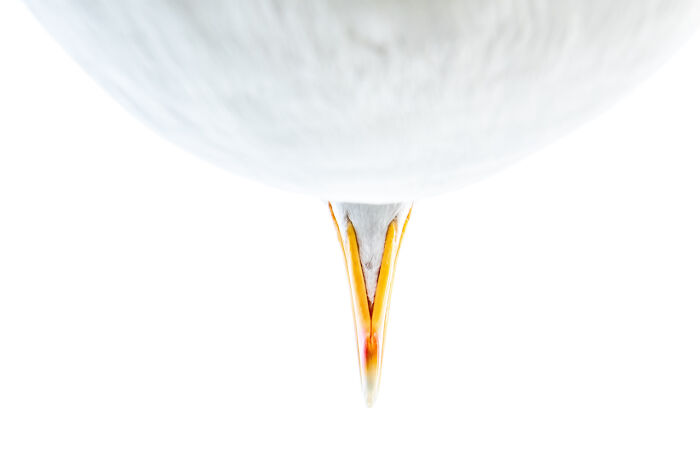
“The Adda River, which flows near my home, is the body of water I know best. I often go snorkeling here, trying to capture fish through my lens. One day, I decided to focus on the European catfish (Silurus glanis), an invasive and predatory species that has spread through the Lombard waters in recent decades and now thrives throughout the Po basin. These non-native species have a significant impact on local biodiversity, causing the decline of native species and disrupting the balance of ecosystems.I went to an area known for the presence of these fish, even though they are difficult to spot during the day. That day, however, I was lucky: beneath a pile of logs deposited on the riverbed, I spotted the shape of a fish. As I submerged to try to photograph it, I was surprised to discover that there were two. The two European catfish seemed to be embracing tenderly, and the pile of logs formed a natural frame, creating an image reminiscent of a pair of newlyweds.When I surfaced, I carefully reviewed the shots, hoping that at least one was well-lit and managed to capture the scene I had just witnessed on the muddy riverbed.”
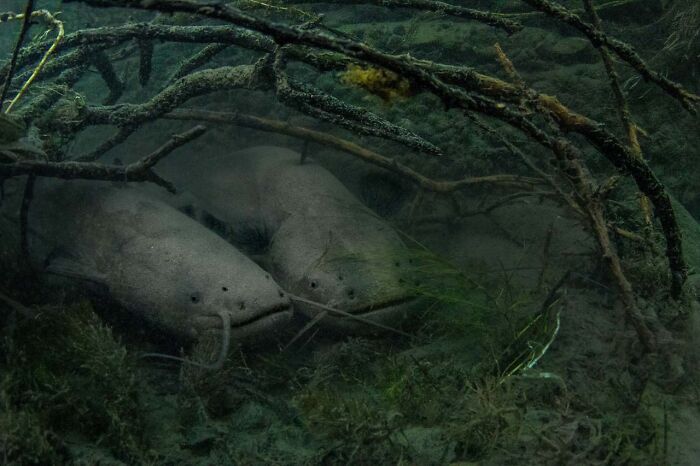

“After being playful with mud and dust, a herd of Sri Lankan elephants walks towards a waterhole on their daily path. The darker elephant in the middle had just returned from a solo bath and decided to join the gang anyway, to return to the waterhole and have some fun again. I was mostly documenting the elephants’ disastrous relationship with uncontrolled garbage dumps in Sri Lanka’s Eastern province, and I noticed that at the end of each day, most of the elephants walk to the water holes, which are located near the fragmented forest blocks, where the elephants rest at night and during the day when the temperatures are too high.Despite the fact that elephants hold the symbolic, cultural, and economic importance in Sri Lanka, a steep decline of this endangered sub-species of the Asian elephant family has been observed, particularly in the last decade. Poaching for ivory, conflicts with humans over the destruction of property and crops, electrocutions through illegal fencing, and irregular garbage dumps have all contributed to the threats in the existence of Sri Lankan elephants, but the greatest threat to their survival is an expanding human population and its demand for land.Significant areas of elephant range are still being lost to development, with a number of irrigation and development projects, resulting in the conversion of more elephant ranges to irrigated agriculture and settlements.”

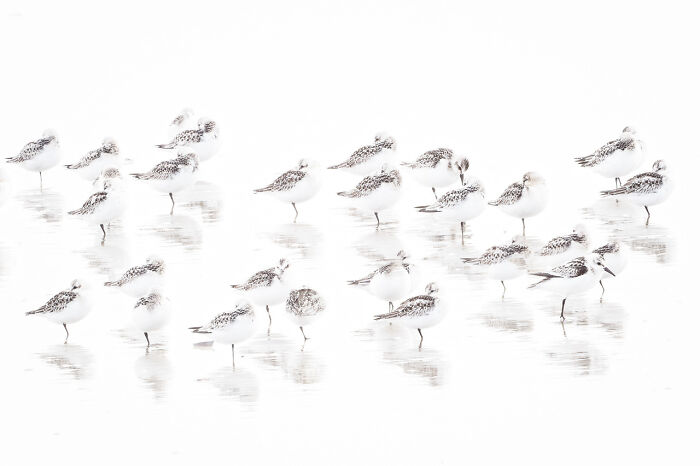
“An Antlion flies in the summer night over the Hungarian steppe. At the end of July, as evening falls, they begin their mating flight in masses. I wanted to capture this moment. To show the dynamics of their movement, I chose a long exposure time of zero point three seconds. I followed the antlion with a LED lamp, manually adjusting the focus on the lens. The flash flashed on the second curtain.Thanks to the long exposure time and the LED lamp, the flapping of the wings can be seen. And finally, the flash froze the antlion. I spent a total of 10 evenings with them, taking over 10,000 pictures. But maybe only 10 turned out well. This is one of my favorites.”

“Nature can also be found in urban areas, especially if there is water and food to be found. There is no shortage of water in the Amsterdam canals. Opportunistic animals such as birds in particular make grateful use of all that water and the food scraps that people leave behind.Birds in the city are generally a lot less shy than their counterparts in the countryside or in the woods. This makes them easier to approach and therefore easy to photograph. This black-headed gull swam back and forth in a canal Amsterdam in the hope of finding something tasty to eat. The reflection of a colorful billboard could be seen in the water surface. I hoped that the gull would swim through the reflection so that I could capture it among all those colors. After some patience, the gull did what I wanted and I was able to take this colorful photo.”

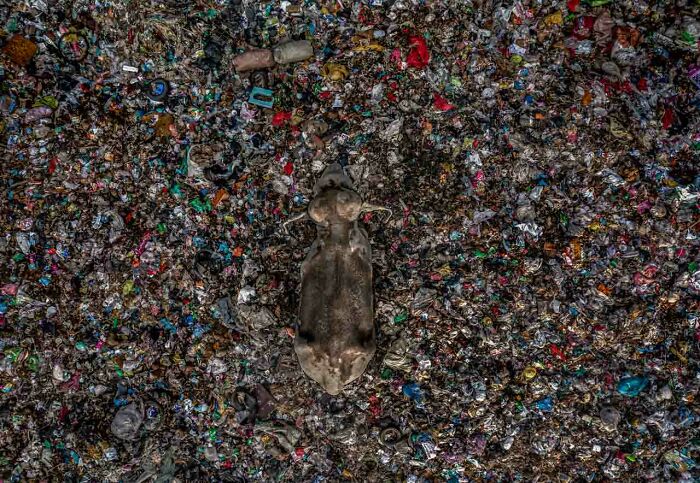
“There is a mute swan colony at Jägersee that I often visit, particularly in winter. The lake’s biodiversity is limited, so I usually focus on photographing the swans. Being a mountain lake, Jägersee is frequently blanketed in snow, as it was on this visit. Initially, I used a telephoto lens to capture images of the lone swan visible that day. While the photos turned out well, they lacked a certain vibrancy. I then switched to a portrait lens with an open aperture to capture the icy landscape and freeze the motion of the falling snowflakes. The resulting image is very atmospheric and recreates the atmospheric cold of the day.”
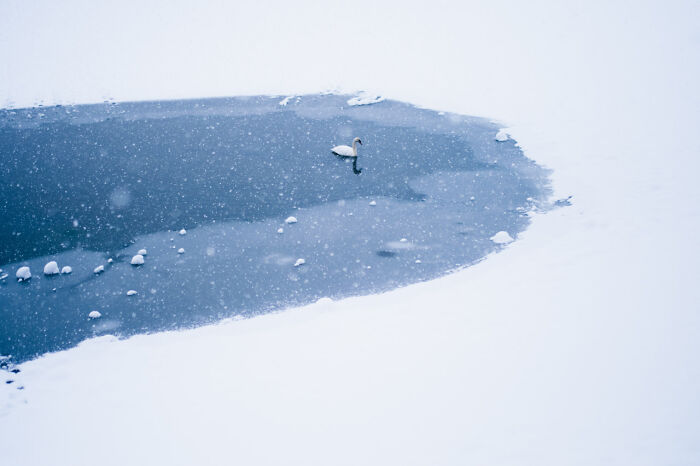
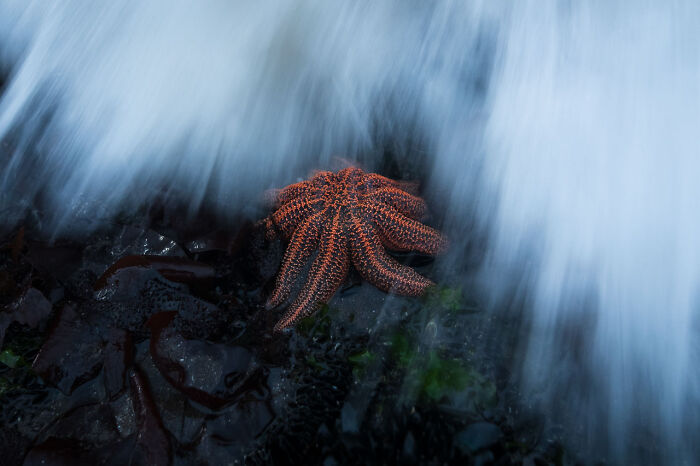
Continue reading with Bored Panda PremiumUnlimited contentAd-free browsingDark modeSubscribe nowAlready a subscriber?Sign In
Continue reading with Bored Panda Premium
Unlimited contentAd-free browsingDark mode
Unlimited content
Ad-free browsing
Dark mode
Subscribe nowAlready a subscriber?Sign In
See Also on Bored Panda
“My former English teacher, who had been following my career, informed me about an intriguing scene on his classroom window and asked if I might be interested in photographing it. When I saw it, I immediately called him, asking him to ensure that no cleaners disturbed the area. Unfortunately, I was abroad at the time, but I promised to visit as soon as I returned.Later, I discovered what had happened: sparrow hawks had been chasing pigeons in the schoolyard, and in their frantic escape, some pigeons tried to fly through the double-insulated windows. The collision left dust from their plumage adhered to the glass, forming a haunting, ghostly outline of their final moments.Each year, millions of birds lose their lives from collisions with glass in human structures. A solution to this problem is long overdue.”
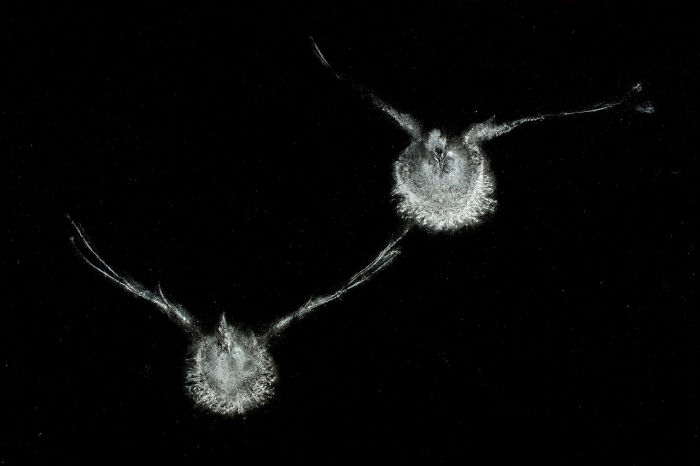
“This photo was taken at the Tintillo River, a tributary of the Odiel River in the province of Huelva, Spain. A unique feature of this river is the terraced riverbed formations, known as stromatolites. From an aerial perspective, these formations reveal striking beauty, often leaving viewers wondering what they are seeing. All of this is the result of cyanobacteria activity.The fallen tree visible here is a stone pine (Pinus pinea), a species that has survived for many years alongside the river’s extremely acidic waters, with a pH around 2.Although I was familiar with this river, its difficult access had kept me from venturing close to its source. This time, I had my drone with me and saw a wonderful opportunity to fly it.”
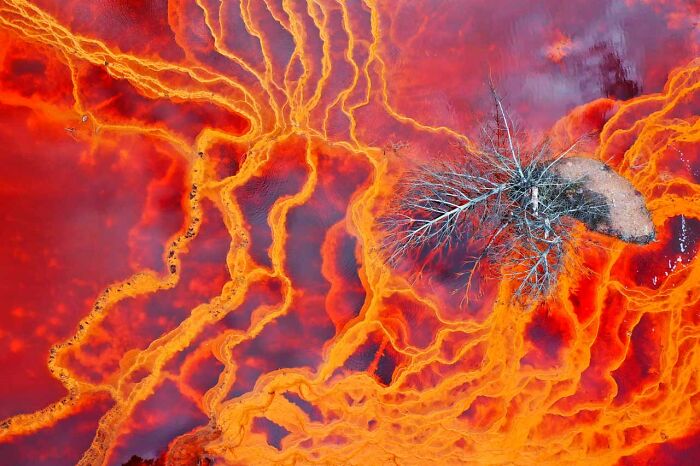
“Glenmalure in Co. Wicklow, Ireland, is a haven for waterfalls, many of which are hidden within its mountainside forests. Whenever I get the chance, I like to explore this area, especially after heavy rainfall, to see what I can discover.On this particular day, it had been raining heavily all week, and it was still pouring when I set out in search of new waterfalls. I followed a river through one of my favorite forest areas, hoping to come across something that caught my eye. The river led me slightly off the beaten track, and given the weather conditions, it wasn’t easy to follow in certain sections.I paused at several spots along the way to take pictures, but it was discovering this small group of waterfalls that made the journey worthwhile. The autumn leaves decorated the scene, and the river’s high-water level imbued it with energy. I used a slow shutter speed to capture the motion of the waterfalls. I also noticed a small pool beside one of the falls, where the swirling water created a perfect pattern, providing an ideal foreground for my composition.Behind the waterfalls, an opening in the canopy allowed light to filter through, creating an atmosphere and mood that perfectly captured the beauty and mystique of these Glenmalure waterfalls.”

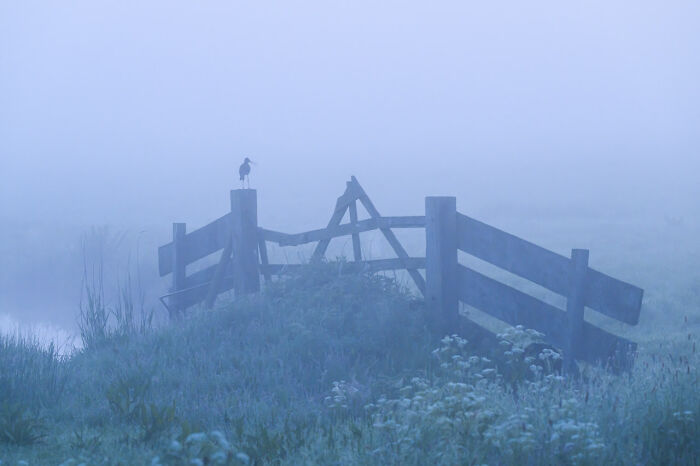
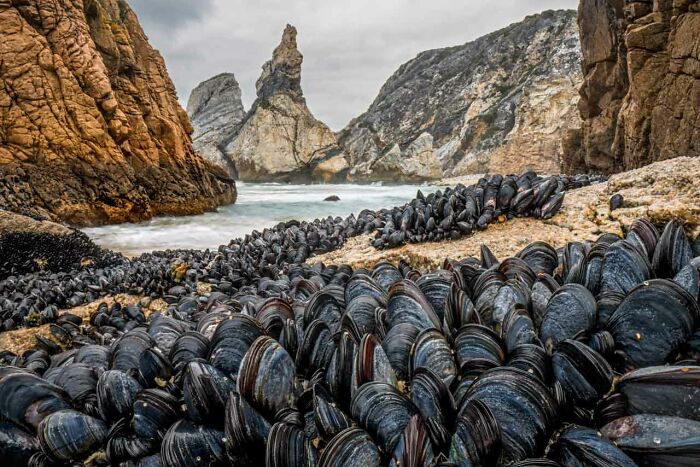
“After heavy rain, I noticed that small pools had formed in the leaves of water lilies in a small pond. While photographing the leaves, a tiny tadpole swam into one of the water droplets resting on a leaf and began moving around inside it. After a few moments, it disappeared back into the pond to rejoin its many siblings.The image was taken in a small pond located in parkland in Ede, The Netherlands.For me, this scene symbolizes the threat of climate change and the shrinking of natural habitats. The leaf resembles a small planet floating in the vastness of the universe. It serves as a reminder that we cannot escape our responsibilities and must take care of our own planet. The tadpole in its tiny droplet represents the next generation, which will have to cope with the legacy of our actions.The tadpole is a brown frog (Rana temporaria). I observed the tadpole swimming in the water droplet before it returned to the pond.”

“Near my home in the Jura Mountains of Switzerland, there is a small colony of ibex. They were reintroduced in the middle of the 20th century after ibex were hunted to extinction in the 19th century in Switzerland.While in summer, the male ibex spend most of their time separately, hidden in the lower woodlands, with the beginning of winter, the rutting season starts. The bucks make their way up to the higher plateau where the females stay with their young. They often walk quite long distances in their excitement, through heavy snow, following the females’ scent. But when the weather conditions are too harsh, they tend to stay hidden in the steep walls and are hard to find.On this particular day, the lonesome male made his way all around the rocky cirque in search of the herd, but unfortunately, he didn’t succeed.I thought the picture with the lone ibex, small in the frame, allowed me to show the harsh conditions bucks face during their rutting season, which coincides with often scarce food sources and deep snow, making long treks quite a strenuous quest.”

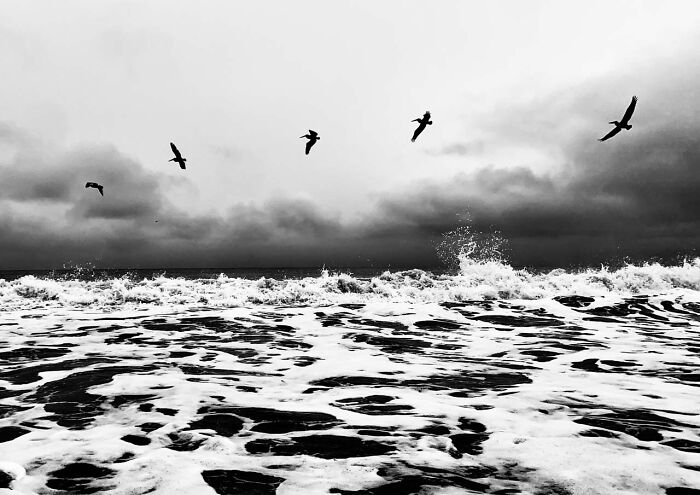
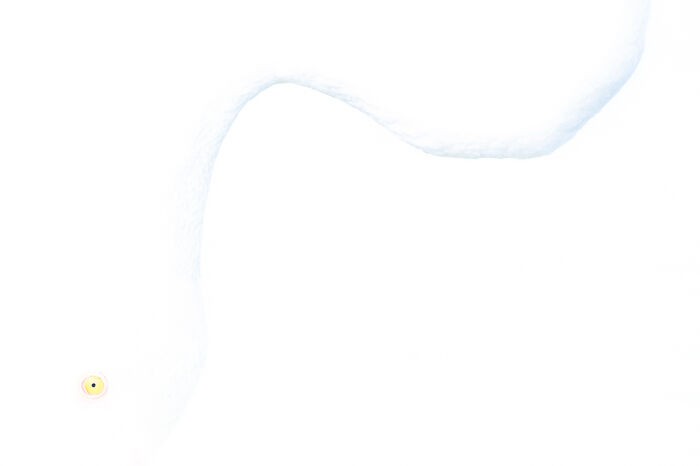

“The transformation of forests, in particular, has captivated my mind for a long time. I have been monitoring the state of forests, tree plantations, logging, and the decline in biodiversity. The signs of the climate warming and climate change are also one concern to document, as Finland’s climate is warming significantly faster than the global average. Finnish forests are beginning to resemble monoculture tree plantations, and finding diverse, multi-aged forests is becoming increasingly difficult, mainly possible in nature reserves and national parks.This ancient pine tree grows amidst a mature pine forest on one of the most beautiful ridges and ridge roads in North Karelia, in Kontiovaara. And just this year, there are plans for logging operations in this unique landscape.I often photograph from a bird’s-eye view with a drone. It allows for the detection of specific features within the larger landscape, revealing the tree within the forest.In this image, I particularly appreciate the story it tells: the trees, all of the same age, that have missed their mark. Only the Ancient wise tree has found the core. In the photo the cloudy weather reflects the current prevailing winter conditions, with the sun rarely shining during winter and the amount of winter rain- and snowfall is rising. The melting snow from the bases of trees tells about the early spring and faster and faster snow melting. This is causing higher floods.I thank the jury for highlighting these important observations and concerns about forests, climate, and biodiversity.”
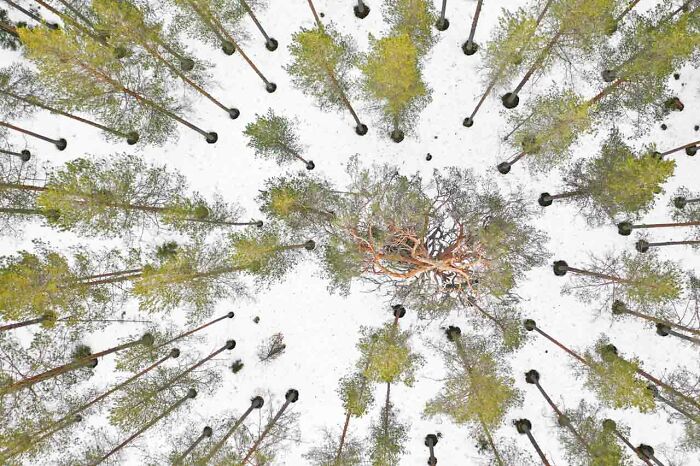
“This image was captured in the heart of the Danum Valley in Borneo, at a scientific research station. I observed these hornbills perching early in the morning near fruit trees, spending considerable time grooming and tending to each other in an almost ritualistic manner. On the second day of seeing them in the same spot, I decided to bring my camera and focus on documenting their behavior.White-faced hornbills are known for the strong bond between the male and female, which is reinforced through acts of affection. In this particular image, I chose to highlight the female as she gently preens the delicate feathers behind the male’s eyes; a touching act of care and tenderness that reflects the depth of their connection.”
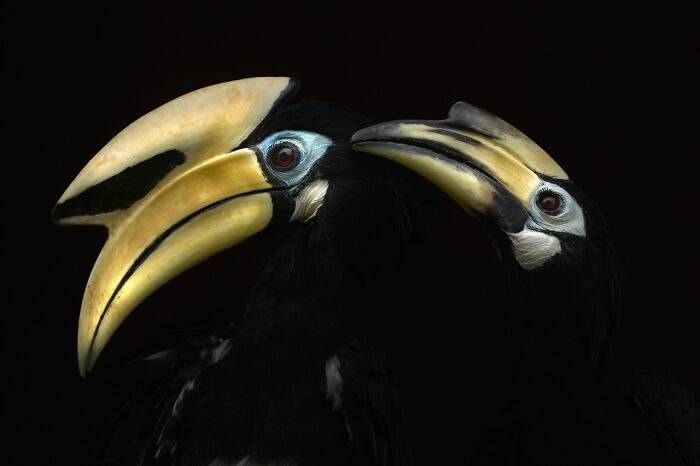
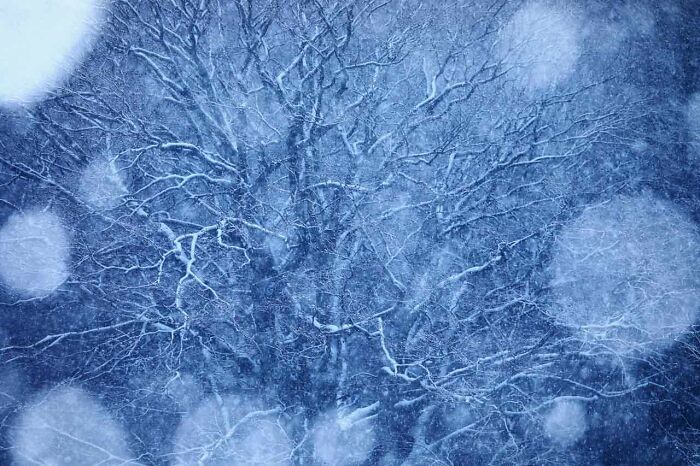
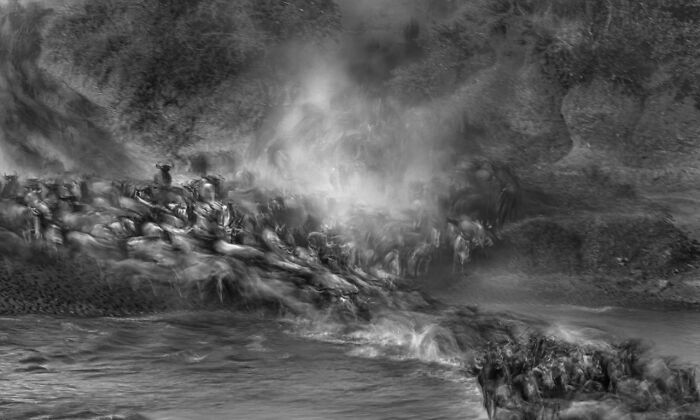
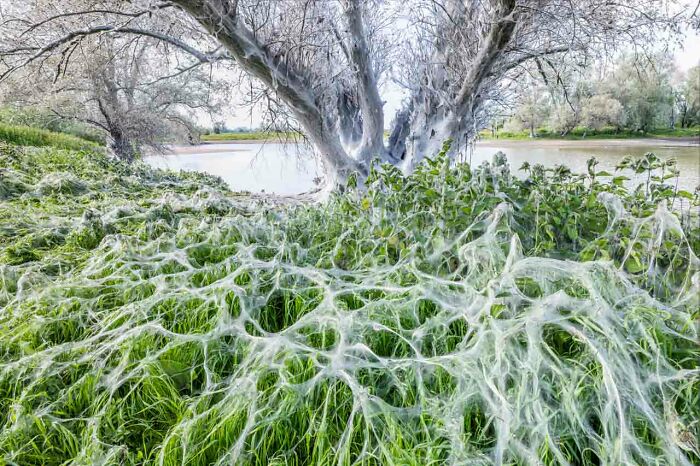
“During the rainy season, the Rift Valley transforms into a mesmerizing spectacle as flamingos grace the landscape with their elegant presence. Their long legs, graceful necks, and striking pink feathers create a vivid contrast against the earth, which takes on a rosy hue from the reflections of the sky and water.Witnessing these magnificent birds in flight feels like attending a nature’s beauty pageant, where every movement and pattern is a testament to the artistry of the natural world.In this particular frame, I was fortunate to capture a breathtaking moment where the flamingos soar across the landscape, their delicate pink hues harmonizing with the soft, rosy tones of the earth below. The image reflects the splendid variety of patterns and colors that emerged as I spent time observing and photographing these stunning creatures.Each shot was a chance to capture the unique interplay of their vibrant plumage and the surrounding environment, but this photograph stands out as one of the most captivating from my collection. It beautifully encapsulates the fleeting elegance of these incredible birds and the ephemeral beauty of their habitat.”


“Fall is my favorite season because of the beautiful fall colors and the mushrooms that appear everywhere at this time of year. Most mushrooms grow in the forest and that is where I found this beautiful mushroom. I positioned myself so that the light of the rising sun was shining through the cap of the mushroom.By using a blue-white balance, the gills are blue in color and the warm color of the rising sun between the gills stands out more. Using my ultra macro lens I was able to get really close and take this abstract photo of the gills of the mushroom. I did not use a special technique.”

“In the early hours of a misty autumn morning, I found myself enveloped in the tranquil silence of an unused section of a NATO military training site. The air was crisp, and a thin veil of fog covered the ground, creating an ethereal atmosphere. I waited patiently, my camera set on a tripod, hoping to catch a glimpse of the elusive stag known to roam these parts.As the fog began to lift, I noticed movement in the distance, a murmuration of birds weaving synchronized patterns against the soft, foggy backdrop. In the midst of this natural spectacle, the majestic stag appeared, its antlers piercing through the mist as it stood still, almost as if in silent acknowledgment of the beauty around it. Including both the birds and the stag in one frame proved challenging, as the starlings moved unpredictably through the fog.A lighthearted moment unfolded when a few starlings briefly landed on the head of one of the deer, creating an almost whimsical scene in the otherwise serene setting. Capturing this moment was no easy task. The low visibility and erratic flight of the birds made composition difficult. I had to adjust my camera settings quickly to capture both the motion of the birds and the stillness of the stag with clarity and sharpness. Patience and anticipation were essential, understanding the behavior of the wildlife and adapting to the shifting light made all the difference.”
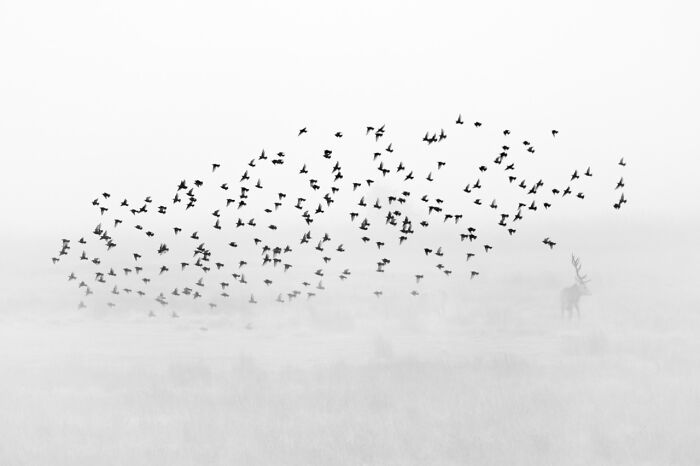
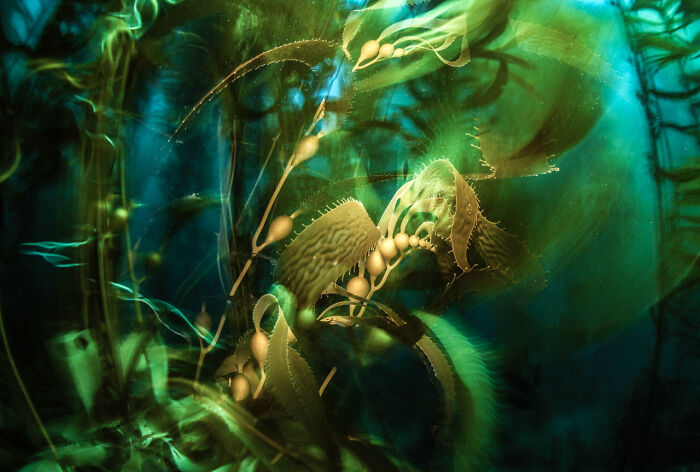
“This is the face of a Mediterranean Monkfish (Lophius piscatorius). I found this beautiful fish resting on a rocky wall at about 15 meters depth. This fish is an ambush predator, perfectly camouflaged with the environment. It uses a fleshy appendage on the first ray of its dorsal fins, which resembles a small fish, to attract its prey.This picture was taken in Rabac, Croatia, Adriatic Sea.This picture is part of a series on ambush predators. I used a technique involving slow shutter speed and deliberate camera movement to obtain a blurred image, combined with flash lighting to create a perfectly still and sharp image overlay. This is a single shot with slow shutter speed using natural light and artificial light.”

“Banded pincer weed, Ceramium ciliatum, viewed under UV light to reveal hidden auto-fluorescing structure. Photo-stackingThe chlorophyll in the pincer weed fluoresces red – dead and dying cells are fluorescing yellow/orange. The weed is covered in a transparent slime in which are living a multitude of unicellular organisms such as diatoms, other algae and bacteria – all fluorescing as red dots.Rocky shore, St. Andrews Bay, Fife Scotland.”
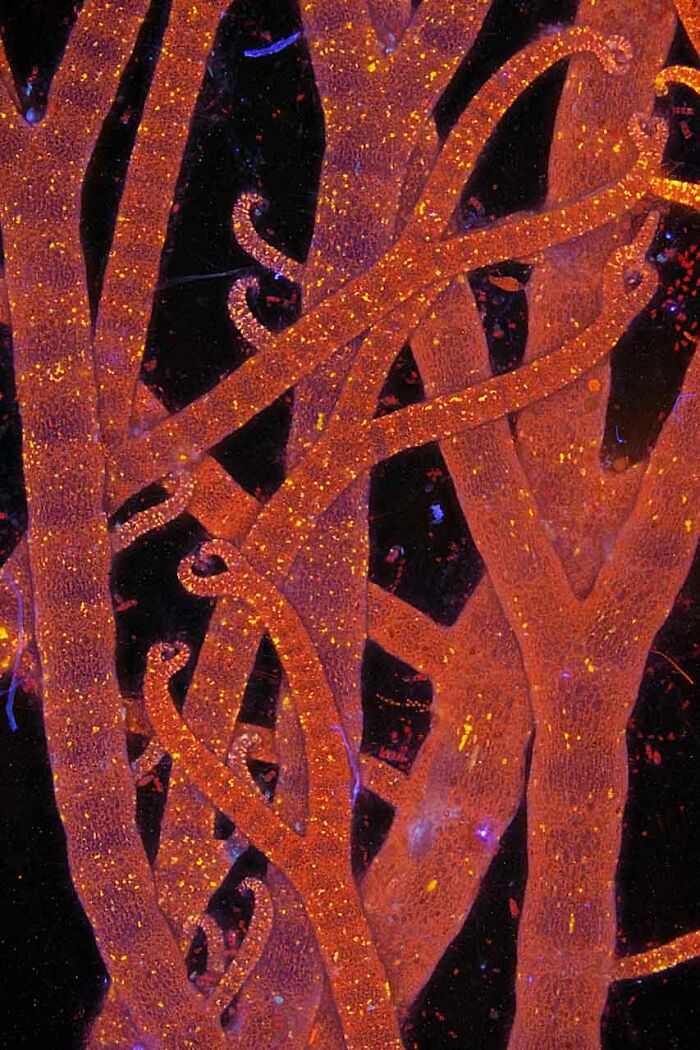
“In my photography job I’m lucky enough to travel extensively and one of my favorite areas to work is Iceland. Iceland is a volcanic island in the North Atlantic Ocean. With open countryside, sea, fjords, waterfalls, mountains, glaciers, green plains and volcanic activity, Iceland has a lot to offer in terms of landscape. When the sky is blue and sunny, I don’t take as many photos. But when it’s windy, snowing and so-called ‘bad’ weather, then it’s good photo weather for me.The photo of Black Lava Beach was taken in January 2024. It was quite windy and the waves hit the land hard. Then it started snowing. I noticed interesting formations in the sand and took quite a few pictures of it. I had a drone with me but was a bit unsure about how safe it was to send it up in such snowy weather with strong winds. Luckily I took the chance. I had the drone adjusted so that I was satisfied with the composition. The camera pointed straight down and that helped quite a bit in terms of not getting snow on the lens.I like to play with contrasts. The white snow against black lava beach inspired me. It gave a nice gray scale and structure in the sand. When I look at the picture, it shows a lot of what Iceland is, but in an abstract way. The snow has created a pattern that resembles mountains and valleys. Iceland has a lot of water and sea, and not least a lot of stormy weather.I am very grateful and happy that the jury has seen potential in this picture. It’s a slightly ‘different’ landscape photo and perhaps a bit odd for some, but hopefully interesting and inspiring too.”
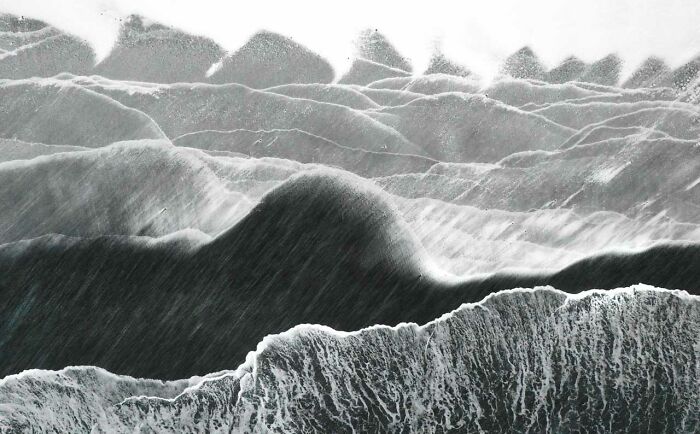
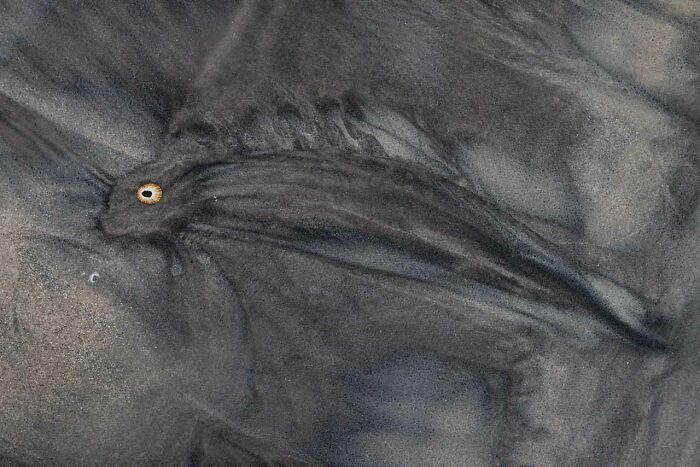
“One morning we decided to go to the reservoir early to take photos of the sunrise with the osprey. When we saw it we realized that there were herons too, but when we revealed it at home, we saw that on one of the highest twigs was the kingfisher. The eagle usually perches most of the time to hunt just like the kingfisher.”
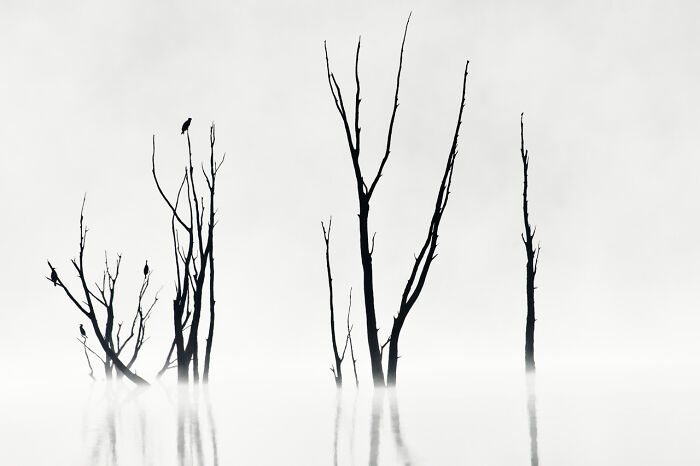

“When heavy snow begins to fall on Castelluccio, the landscape quickly transforms. The vast open spaces of the Pian Grande are gradually blanketed in white, creating a seamless, endless expanse. Snow covers every surface, evoking a sense of purity and continuity.The sound of falling snow is soft and muted, almost a whisper, as every noise fades away, leaving space for absolute tranquility and a profound connection to nature. The air is crisp and clean, and breathing it feels like a privilege.Visibility diminishes, creating an effect of isolation, as if you’re in a world apart, far from everything else. The surrounding mountains’ silhouettes blur, while trees and bushes bend under the snow’s weight, taking on new, intriguing shapes.Experiencing a heavy snowfall in Castelluccio di Norcia feels like entering a world suspended in time, where nature’s beauty reveals both its strength and delicacy. It’s an experience that stays etched in memory, evoking deep wonder and serenity.”

Modal closeAdd New ImageModal closeAdd Your Photo To This ListPlease use high-res photos without watermarksOoops! Your image is too large, maximum file size is 8 MB.Not your original work?Add sourcePublish
Modal close
Add New ImageModal closeAdd Your Photo To This ListPlease use high-res photos without watermarksOoops! Your image is too large, maximum file size is 8 MB.Not your original work?Add sourcePublish
Modal closeAdd Your Photo To This ListPlease use high-res photos without watermarksOoops! Your image is too large, maximum file size is 8 MB.Not your original work?Add sourcePublish
Add Your Photo To This ListPlease use high-res photos without watermarksOoops! Your image is too large, maximum file size is 8 MB.
Add Your Photo To This List
Please use high-res photos without watermarks
Ooops! Your image is too large, maximum file size is 8 MB.
Not your original work?Add source
Modal closeModal closeOoops! Your image is too large, maximum file size is 8 MB.UploadUploadError occurred when generating embed. Please check link and try again.TwitterRender conversationUse html versionGenerate not embedded versionAdd watermarkInstagramShow Image OnlyHide CaptionCropAdd watermarkFacebookShow Image OnlyAdd watermarkChangeSourceTitleUpdateAdd Image
Modal closeOoops! Your image is too large, maximum file size is 8 MB.UploadUploadError occurred when generating embed. Please check link and try again.TwitterRender conversationUse html versionGenerate not embedded versionAdd watermarkInstagramShow Image OnlyHide CaptionCropAdd watermarkFacebookShow Image OnlyAdd watermarkChangeSourceTitleUpdateAdd Image
Upload
UploadError occurred when generating embed. Please check link and try again.TwitterRender conversationUse html versionGenerate not embedded versionAdd watermarkInstagramShow Image OnlyHide CaptionCropAdd watermarkFacebookShow Image OnlyAdd watermark
Error occurred when generating embed. Please check link and try again.
TwitterRender conversationUse html versionGenerate not embedded versionAdd watermark
InstagramShow Image OnlyHide CaptionCropAdd watermark
FacebookShow Image OnlyAdd watermark
ChangeSourceTitle
You May Like40 Captivating Street Shots Curated By “Pure Street Photography"Community PandaPhotographer Assembles Aerial Photos To Showcase The Immense Scale Of Human Impact (17 Pics)Community Panda64 Of The Most Famous Photographers In HistoryViltė Domkutė
Community Panda
Viltė Domkutė
Art